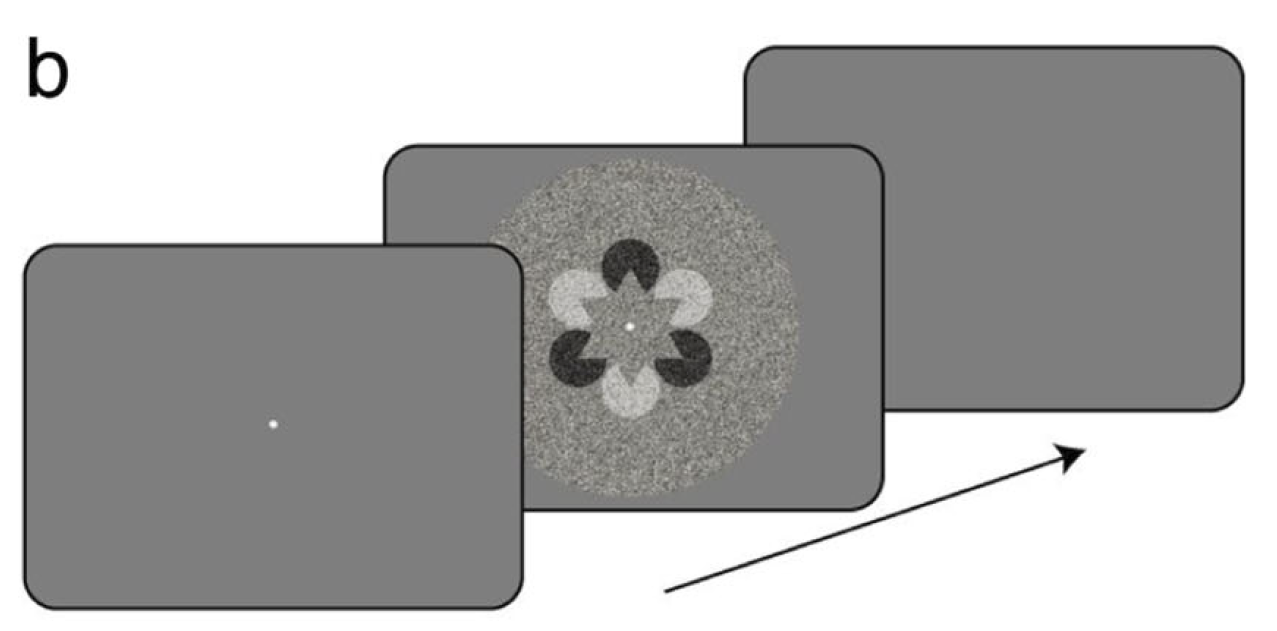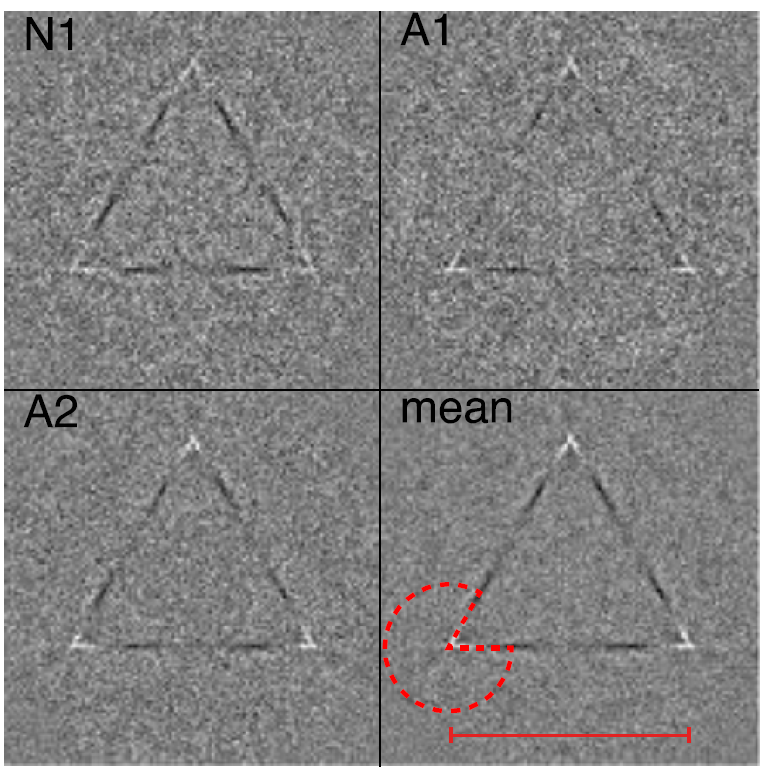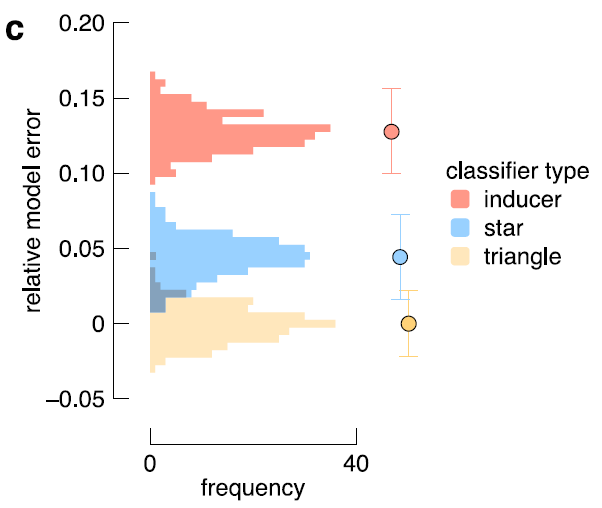Clutter is a fact of life. Wherever you look, there is clutter. Even the tidiest of tidy rooms will contain much visual clutter: some objects will be in front of others, thereby partially obscuring them. So if you need to reach for the cup that’s behind the toaster, then your visual system must work through that clutter and must work out which visual signals belong together and define an object.
Our visual system is surprisingly good at this task. Consider the famous Kanizsa triangle in the figure below:

The white triangle on top of the other shapes instantly jumps out—and yet it is only “hinted at” by cleverly-placed gaps in the black triangle and missing slices in the black “pies” (or “PacMan faces”).
We now know that the visual system can use differences in luminance to detect borders with great efficiency. What is less clear, is whether this boundary detection operates pre-attentively and computes a visual structure (such as the triangle above) independent of one’s attention, or whether this structural computation depends on the state of attention.
 A recent article in the Psychonomic Society’s journal Attention, Perception, & Psychophysics addressed this question. Researchers William Harrison and Reuben Rideaux created a new version of the Kanizsa triangle, shown in the figure below:
A recent article in the Psychonomic Society’s journal Attention, Perception, & Psychophysics addressed this question. Researchers William Harrison and Reuben Rideaux created a new version of the Kanizsa triangle, shown in the figure below:

What do you see? Chances are that you perceived a star in the center, which is created (i.e., implied) by the 6 PacMan inducers. However, other interpretations are possible: Suppose you ignore the black inducers and focus on the three white PacMan faces only. In that case, you might see a downward pointing triangle rather than a star. Or suppose you focus on the black inducers instead: in that case you should see an upward-pointing triangle and nothing else.
All of this might happen, but it can only happen if attention can direct construction of a visual structure—if not, then we might be stuck with the star forever.
Harrison and Rideaux examined the role of attention by presenting three observers (two of whom were the authors themselves and hence very experienced whereas the third one was a member of the public) with a large number of trials in which a noisy variant of the above stimulus was presented, and observers had to decide whether the tips of the upright or the inverted triangle were narrower or wider than an equilateral triangle—this varied between trials because the jaw angle of the PacMan inducers was randomly varied. Sometimes the angle was in excess of 60°, sometimes it was less. The figure below shows a sample trial.

In a further crucial twist, observers were cued to only attend to one of the triangles throughout a block of trials. Altogether, observers completed nearly 10,000 trials across 16 blocks.
Because the number of trials was so large, the statistical analysis could quantify the correlation between each pixel in the stimulus and the observer’s report. This, in turn, could reveal the spatial locations that were used to make the judgment by the observer. The figure below shows the reconstructed “classification images” used by the observers—effectively these are the figures that were perceived by the observers, inferred by statistical means from the role of each pixel in driving a response. (To understand the figure it is important to know that the two separate triangles, cued by white and black inducers, were combined by flipping one of them around so it also pointed to the top. The single triangle here therefore is a composite of two different triangles from different blocks.)
Any particularly dark or light pixel in the figure below was involved in making the judgment, whereas the gray pixels played no role. It is clear that all observers focused on the PacMan inducers at the corner of the triangle, although there is also evidence that they used illusory contours. Note the faint lines of non-gray pixels in between the three inducers. Those did not exist in the real world, but pixels in those locations nonetheless affected responding and were therefore “perceived.”

These inferred classification images seem to imply that people focused on the cued triangle only and were not affected by the overall star pattern. To confirm that this was indeed the case, Harrison and Rideaux compared performance to the predictions of a quantitative model that was trained to perform this task under three conditions: attending only to the PacMan inducers, attending only to the cued triangle, or attending to all inducers and the star pattern. The three model variants were compared by tallying their ability to handle the data. The results of this comparison are shown in the next figure.

In the figure, lower model error means better fit between the model and the data. Data points and error bars represent the mean and 95% confidence intervals for each training regime.
The figure is unambiguous: the model that was trained to perceive a complete triangle provides the best fit to the data—far better than a model that was trained on the complete star pattern or the inducers alone.
The implications of this result are that people form illusory contours between attended visual features, even though the constructed contours are in conflict with equally plausible other implied structures, namely the star pattern. In other words, voluntary attention can guide the fundamental processes involved in the construction of a perceptual structure. Attention is the master of this process, rather than just being taken along for a ride by low-level visual processes.
Or, as Harrison and Rideaux put it:
“Given that the illusory edges of the triangle implied by the attended inducers directly conflicted with the regions of the competing implied figures (i.e., the star and inverted triangle), our finding that illusory edges were interpolated between attended inducers reveals that attention can determine depth order, even when the figures and ground are illusory. Spatial structure is thus computed by neural operations that are at least partially contingent on the voluntary state of the observer”
So if you prefer an illusory triangle to an equally illusory star, there is nothing stopping you from seeing that triangle only.
Psychonomics article highlighted in this post:
Harrison, W. J., & Rideaux, R. (2019). Voluntary control of illusory contour formation. Attention, Perception, & Psychophysics, 81, 1522-1531. DOI: 10.3758/s13414-019-01678-8.
